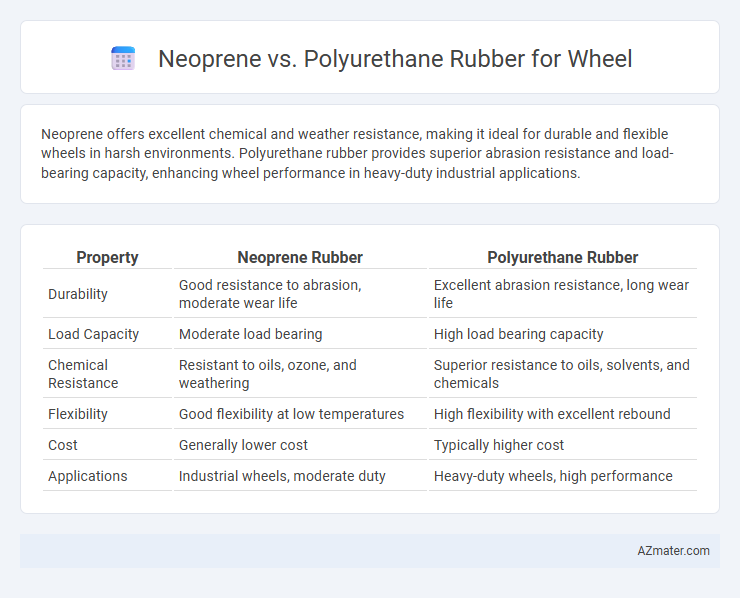Neoprene offers excellent chemical and weather resistance, making it ideal for durable and flexible wheels in harsh environments. Polyurethane rubber provides superior abrasion resistance and load-bearing capacity, enhancing wheel performance in heavy-duty industrial applications.
Table of Comparison
| Property | Neoprene Rubber | Polyurethane Rubber |
|---|---|---|
| Durability | Good resistance to abrasion, moderate wear life | Excellent abrasion resistance, long wear life |
| Load Capacity | Moderate load bearing | High load bearing capacity |
| Chemical Resistance | Resistant to oils, ozone, and weathering | Superior resistance to oils, solvents, and chemicals |
| Flexibility | Good flexibility at low temperatures | High flexibility with excellent rebound |
| Cost | Generally lower cost | Typically higher cost |
| Applications | Industrial wheels, moderate duty | Heavy-duty wheels, high performance |
Introduction to Wheel Rubber Materials
Neoprene and polyurethane are two primary rubber materials used for wheels, each offering distinct performance characteristics. Neoprene provides excellent resistance to oil, chemicals, and outdoor weathering, making it suitable for industrial and outdoor applications. Polyurethane excels in abrasion resistance and load-bearing capacity, delivering superior durability and smooth rolling performance in environments requiring high mechanical stress.
What is Neoprene Rubber?
Neoprene rubber, a synthetic elastomer derived from chloroprene polymerization, offers excellent resistance to oils, chemicals, and weathering, making it a preferred choice for industrial wheels. Its balanced flexibility and durability provide superior shock absorption and abrasion resistance compared to polyurethane, enhancing performance in demanding environments. Neoprene's inherent resistance to ozone, heat, and flame makes it ideal for applications requiring long-lasting and reliable wheel materials.
What is Polyurethane Rubber?
Polyurethane rubber is a versatile elastomer known for its excellent abrasion resistance, high tensile strength, and superior load-bearing capacity, making it ideal for wheel applications in industrial settings. Unlike neoprene, polyurethane offers enhanced resistance to oils, solvents, and impacts, contributing to longer wheel life and reduced maintenance costs. Its ability to maintain flexibility across a wide temperature range ensures reliable performance in demanding environments.
Key Physical Properties Compared
Neoprene wheels exhibit superior resistance to oil, chemicals, and weathering, making them ideal for outdoor and industrial applications, while polyurethane wheels offer higher load-bearing capacity, excellent abrasion resistance, and better rebound properties for smoother rides. Neoprene's tensile strength typically ranges from 7 to 12 MPa, with moderate hardness around 50-80 Shore A, whereas polyurethane hardness can exceed 90 Shore A with tensile strength up to 40 MPa. The choice between neoprene and polyurethane wheels depends on balancing durability in harsh environments against enhanced mechanical performance and wear resistance.
Resistance to Wear and Tear
Neoprene offers moderate resistance to wear and tear, providing durability in applications with exposure to oils and weathering, making it ideal for wheels in outdoor environments. Polyurethane rubber excels in abrasion resistance, outperforming neoprene by maintaining shape and structural integrity under heavy loads and high friction. For wheels requiring superior wear resistance and longevity, polyurethane is the preferred choice due to its toughness and resilience in demanding conditions.
Chemical and Environmental Resilience
Neoprene rubber offers superior chemical resistance to oils, solvents, and acids, making it ideal for wheels exposed to harsh industrial chemicals, while polyurethane excels in resistance to abrasion, oils, and mild chemicals but is less effective against strong solvents. Environmentally, neoprene resists ozone, weathering, and UV degradation better, enabling longer service life in outdoor applications. Polyurethane wheels provide excellent mechanical durability and load-bearing capacity but may suffer faster deterioration when exposed to extreme chemicals and outdoor environments compared to neoprene.
Comfort and Noise Performance
Neoprene rubber offers superior shock absorption and vibration damping, making it ideal for wheels prioritizing rider comfort and smooth operation. Polyurethane rubber delivers excellent noise reduction due to its higher density and resilience, providing quieter wheel performance on various surfaces. Both materials balance comfort and noise differently, with neoprene excelling in cushioning while polyurethane minimizes rolling noise effectively.
Cost and Availability Analysis
Neoprene rubber wheels typically offer a cost-effective solution with widespread availability due to established manufacturing processes and extensive distribution networks. Polyurethane wheels, while often more expensive, provide enhanced durability and resistance to abrasion, which can justify higher prices in long-term applications. Availability of polyurethane wheels may be more limited compared to neoprene, especially in specialized formulations or sizes, influencing procurement decisions based on project timelines and budget constraints.
Best Applications for Neoprene Wheels
Neoprene wheels excel in applications requiring excellent resistance to oil, chemicals, and weathering, making them ideal for industrial carts, conveyor rollers, and casters in harsh environments. Their superior cushioning and abrasion resistance provide smooth operation on rough surfaces and reduce noise in material handling equipment. Neoprene's durability and versatility outperform polyurethane in settings with exposure to ozone, UV rays, and moderate mechanical stress.
Best Applications for Polyurethane Wheels
Polyurethane wheels offer superior abrasion resistance, load-bearing capacity, and chemical resistance compared to neoprene, making them ideal for industrial applications such as conveyor systems, forklifts, and heavy machinery. Their excellent elasticity and tear strength ensure durability on rough surfaces, while their resistance to oils, solvents, and corrosion extends their lifespan in harsh environments. Polyurethane wheels are preferred in settings requiring high-performance wheels that maintain traction, minimize noise, and reduce wear on flooring.

Infographic: Neoprene vs Polyurethane rubber for Wheel
 azmater.com
azmater.com